Financial markets have come to expect minor and gradual 25 basis point increases in the federal funds rate every time the Federal Open Market Committee meets. Most expect the group to continue along their predictable path towards increasing the rate to 3 percent from 2.75 percent during their upcoming conference. At the time when Alan Greenspan decided to take the "slow and steady" route towards a tigher monetary policy, the economic climate was different. Inflation was low and productivity was strengthening. However, recent data suggest inflation may be rising considerably while productivity may be slipping.
Of sole comfort to economists and policymakers this week was the release of new home sales data which showed a rise in March up 12.2% to an annual rate of 1.431 million units. The increase may suggest swift economic momentum despite surging oil prices and other lackluster data released this week. In fact, the Conference Board's consumer confidence index reached a gloomy 97.7 in April and was part of a consecutive slide in the index for three straight months. In January, the index had a reading of 105.1 while it reached a value of 103.0 in March. The poor jobs market, in addition to high gas prices, may have had an effect on the value of the index. 5,000 consumers throughout the US are surveyed every month with regards to their attitudes on present economic conditions. To add insult to injury, the dollar dipped in initial reaction to the release of durable goods orders data which showed a drop of 2.8 percent in March. With these contradictory bits of data, it may not be very clear what condition the US economy is in (or might be headed towards) and whether interest rates will rise at their expected rate during the next Fed meeting.
Nevertheless, solid housing market data may overcompensate and lead to strong support for the dollar. On the other hand, the Beige Book report, which the Fed uses to keep tabs on economic activity throughout the nation, suggested an increased strength in upward price pressures (inflation). The housing market data may simply form part of a micro-bubble, as was the case with internet equity back in the late '90s, however, policymakers have vigorously discounted such a theory.
Despite the numbers out this week, there may be some light at the end of the tunnel. The Energy Information Administration's Petroleum Status report for the week of April 22nd indicated an increase of 5.5 million barrels of crude oil reaching 324.4 million. When oil inventories rise, it usually leads to a drop in oil prices and consequently a drop in gas prices. Although consumers have reigned in their spending habits in reaction to higher gasoline prices, that may be due to change in the near future. Indeed, based on the status report, the US may not end up seeing $3 gas prices during the summer of '05 and the US economy may not suffer as much as was expected. Federal Reserve members will probably keep this in mind.
Meanwhile, economic indicators from Japan showed consumer prices dropped during the 2004/2005 fiscal year for a seventh straight year in a row suggesting that deflation in the Land of the Rising Sun may last for yet another year. The US dollar neared 106 yen after hovering around 25 pips above 105 earlier. Consumer confidence in Japan may still play a role in the yen's value. Asian finance ministers and others will be meeting in Istanbul as part of the Asian Development Bank conference next week. China and Japan's finance ministers are expected to attend the meeting and will be looking forward to discuss plans to revalue China's currency.
Weak growth in the euro zone, according to Germany's economic research institutes, did not provide support for the euro. What's more, business confidence in France dropped considerably in April and this may also have an effect on expectations for the euro. The euro traded at around $1.2973 dropping against the dollar on this recent data. This week's news of the record rate of new US home sales may certainly not bode well for the euro either.
There will be many developments to look forward to in the coming week. Of particular importance to currency traders will be the outcomes of the FOMC meeting as well as the ADB conference meeting. Federal Reserve officials will have quite a considerable puzzle to solve at their meeting next week. They may end up abandoning their proposal for *measured* rate hikes. Likewise, China may put forward efforts to revalue the yuan. Next week will certainly be an interesting time for those in the forex market.















